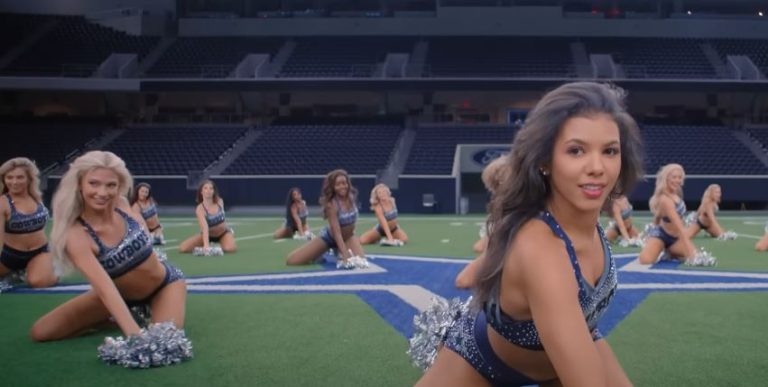The Dallas Cowboys cheerleaders witnessed a long-overdue, comprehensive pay raise during the most recent NFL season, which is uncommon for professional dance teams. Years of what many referred to as symbolic compensation later, their tenacious advocacy paid off—and in a big way. Veteran squad members like Megan McElaney and Jada McLean spearheaded a covertly calculated attempt to address the growing public concern. The Netflix documentary series America’s Sweethearts, which openly depicted the financial strain, emotional toll, and physical demands faced by these highly skilled performers, made the movement especially noticeable.
Prior to the raise, the majority of cheerleaders made about $500 per game and $15 per hour for rehearsals. It was a sum that, even when added to flat fees for appearances, hardly touched the expenses of living, transportation, clothing, and medical care for injuries. Even though each DCC member had to be extremely athletic and visible, the reality was remarkably similar to other underpaid performance roles, leading to public comparisons to minimum wage fast-food jobs.
Simple Table (Cowboys Cheerleaders Salary Overview – 2025)
| Detail | Information |
|---|---|
| Team Name | Dallas Cowboys Cheerleaders (DCC) |
| Squad Size | 36 active members |
| Previous Game Pay (2024) | $500 per game |
| Current Game Pay (2025) | Estimated $2,000 per game (400% increase) |
| Previous Rehearsal Rate (2024) | $15 per hour |
| New Rehearsal/Appearance Pay | Up to $75/hour depending on role and seniority |
| Estimated Annual Veteran Salary | Up to $150,000 |
| Additional Pay | Appearance flat fees based on years of experience |
| Health Insurance Provided? | No |
Things drastically changed by 2025. The structure was altered by the 400% pay increase that was reported. Rehearsal pay has also significantly increased, with seasoned players reportedly earning up to $2,000 per game and $75 per hour for certain events. Some veterans were able to earn up to $150,000 annually, which was especially advantageous because many of them worked at other jobs to make ends meet. Previously, their roles hovered between honorary and professional; now, they feel much more in line with a long-term career.
The Netflix series’ climactic episodes made the emotional impact particularly evident. Through tears, McElaney described how the financial victory was a source of both relief and validation. She was now contributing to a restructuring of the way talent is regarded, not just dancing. In multiple interviews, McLean echoed that sentiment, describing the victory as more than just a financial one. Younger dancers joining the scene, many of whom had previously viewed cheerleading as a resume builder rather than a serious career, found it to be highly symbolic.
But problems still exist. The Cowboys organization still does not offer health insurance to cheerleaders, even with the improved pay scale. Given the physical demands of cheerleading, this oversight is especially painful. Current cheerleaders like Madeline Salter have documented regular chiropractic and rehabilitation sessions to manage fatigue and nerve pain, while former member Caroline Sundvold disclosed having hip surgery following seasons of punishing jump splits. The organization continues to overlook a crucial component of the professionalization puzzle by failing to cover healthcare.
No one has overlooked that gap. Media and digital platforms have increased the visibility of their struggle, making their cause a more widely recognized symbol. Their battle is part of a larger movement in which female performers and athletes—from Olympic gymnasts to WNBA players—are refusing to accept antiquated compensation structures. Rather, they are establishing new benchmarks and pressuring the leadership to recognize their diverse contributions in terms of money, culture, and society.
One notable example of how media exposure affects results is the Dallas Cowboys cheerleaders’ raise. Time was a key factor, according to Greg Whiteley, the docuseries’ director. Millions watched, heard the facts, and openly wondered how a $11 billion franchise could afford to pay such key players so little. Despite Whiteley’s insistence that he only recorded events rather than influencing them, the increase in attention generated unquestionable momentum.
The cheerleaders’ demands were too obvious to ignore thanks to strategic alliances and constant pressure. Although it’s safe to assume that Netflix did not directly negotiate contracts, by providing a platform, it gave the actors’ voices more weight and shed light on their stories in a manner that spreadsheets and press releases could never do.
The team accomplished a unique transformation by combining collective bargaining with media advocacy. They transformed private annoyance into public discussion, and that discussion—which was frank and intensely intimate—led to actual organizational change. It was more than just money. Being taken seriously was the goal. about pursuing your passions without having to work four jobs. About eradicating the silent embarrassment of putting in extra hours in a prominent position while still struggling to make ends meet.
This fight’s legacy now extends beyond a single NFL season. It influences how future dancers, team captains, and corporate human resources departments will perceive pay. It encourages younger generations to pursue careers in the performing arts by reaffirming that money and passion shouldn’t be incompatible. Other sports teams are also encouraged to reconsider their internal models by the movement. Others may follow if America’s most famous cheer squad can be fairly compensated.
Megan McElaney continues that momentum as she makes a comeback for another season. Even though McLean and Latimer are no longer active, their influence endures, particularly among new recruits who are finally able to view cheerleading as a career rather than just a platform. The reform was long overdue, deeply felt, and hard-won; it wasn’t handed down lightly.


